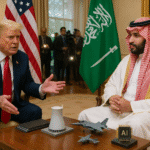The United States’ decision to share intelligence with Ukraine for strikes on long-range energy targets inside Russia represents a pivotal shift in how Washington supports Kyiv. What had been largely a defensive and tactical assistance package is now veering into strategic warfare, with far-reaching consequences for the conflict’s trajectory.
Beyond the Battlefield: A New Phase of Support
For most of the war, U.S. aid to Ukraine focused on short- and medium-range defense systems, training, and battlefield logistics. The new intelligence-sharing initiative will reportedly give Ukraine access to targeting data on Russian oil refineries, power plants, and other energy infrastructure far from the front lines. This kind of support not only enhances
U.S. officials have authorized this intelligence flow to increase the precision and effectiveness of Ukrainian strikes, according to Reuters. By allowing Kyiv to target deeper into Russian territory, Washington is signaling a more aggressive stance that could strain Russia’s domestic infrastructure and its war economy.
Energy Infrastructure as a Pressure Point
Russia’s economy relies heavily on energy exports, which continue to fund much of its military activity. Hitting these assets is intended to undercut Moscow’s ability to sustain the war effort. Ukraine has already demonstrated capability in this area; reports suggest that drone attacks have disrupted as much as 40 percent of Russia’s refining capacity, according to Euronews.
These strikes have led to fuel shortages, logistical slowdowns, and internal political pressure on the Kremlin. With U.S. intelligence in hand, Ukraine could accelerate this trend, creating new vulnerabilities that extend beyond the battlefield.
Risk of Escalation
There is a dangerous tradeoff. By enabling attacks deep into Russia, the United States raises the risk of a broader confrontation. Russian President Vladimir Putin has warned that the delivery of long-range weapons like Tomahawk missiles or enabling such strikes would constitute a major escalation. Putin views such actions as moving beyond support and into active participation.
The Kremlin is also likely to respond by fortifying its energy infrastructure, possibly drawing resources away from the front. More concerning is the risk of retaliatory actions against U.S. or NATO-linked assets. The boundaries between assistance and intervention grow blurrier with each policy shift.
Shaping Ukraine’s Military Strategy
This new intelligence support is expected to influence Ukraine’s doctrine and how it defines success. Long-range operations, once opportunistic, may become central to its war effort. Kyiv is likely to coordinate deeper strikes with greater precision, targeting logistical and economic assets rather than just military concentrations.
Such moves could alter the psychological and strategic balance. A Russia that feels its heartland is vulnerable may behave more cautiously or, conversely, lash out unpredictably. For Ukraine, the ability to strike deeper creates deterrence as well as pressure, not just on the battlefield but at the negotiating table.
A Final Note
U.S. officials appear to be calibrating this shift by limiting the scope of shared intelligence to energy-related targets. This may be an attempt to contain escalation while still enhancing Ukraine’s leverage. Still, once the precedent is set, the temptation to expand the target set could grow.
The decision to provide this level of support signals a new phase in the conflict. It marks the U.S. as not just an enabler of Ukraine’s defense, but a co-architect of its offensive reach. The coming months will reveal whether this bold step brings Russia closer to the negotiating table or drags the war into even more dangerous territory.














